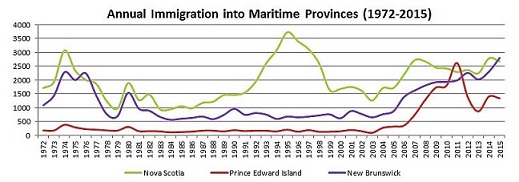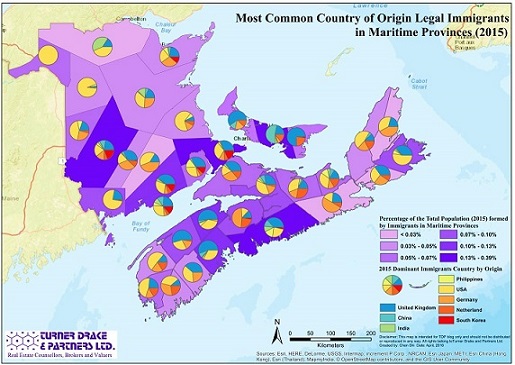Immigration into Canada is nothing new: the country admits an average of 253,875 immigrants each year. This number is responsible for almost two-thirds of the national population growth from 2005 to 2015. Based on a housing demand projection study conducted by the Canada Mortgage and Housing Corporation (CMHC), a 1% increase in immigrant population causes housing demand to rise by about 0.66%. However, the Maritime housing market is facing a projected decline in the coming years due to three interdependent facors: an aging and shrinking population, a dearth of immigration and very low rates of economic growth. This is not new information: alarms were given by various sources and it’s time to halt the slide.
History has proven that an aggressive immigration policy can help smooth the impact of an aging population (e.g. Ontario and Vancouver). It is not surprising, therefore, that increasing migration into the Maritimes is an effective way of addressing the adverse effects of our aging population. New immigrants will not only help increase the production of goods and services but will also directly increase the demand for housing.
Becoming a Maritime immigrant myself, I have a special interest in exploring the relationships between immigrant and housing trends in this region. I came to Canada in late 2012 as an international student and have seen several immigrants who decided to stay and purchase a house here. Many of them are below age 40, well-educated, and economically independent. Do they represent the majority immigrant group in the Maritime Region? I decided to dig into the data to find the answer.
The Maritime Immigration Trends
Immigrants comprise less than 6% of the Maritime Provinces’ total population, but 20.6% of the national population. Immigrant inflows to the Maritimes fluctuated dramatically from 1991 to 2006, however in the last decade, trends have been rising. This can be attributed to new policy initiatives (e.g. provincial nominee program, skilled worker express entry) aimed at attracting more immigrants to the Maritime region. From 2006 to 2011, the number of immigrants to PEI rose six-fold. Not surprisingly, employment growth in PEI caught up with the national average during the same period. Although this growth is from a small base, it still means the island is attracting more than twice as many immigrants compared to its share of the total population.

Maritime Immigrants: Countries of Origin and Demographic Profile
The United States and United Kingdom were the top two source countries of the Maritime immigrants during the 1980s. The position was taken over temporarily by some Middle Eastern countries (in the aftermath of the Gulf War) and China in the 1990s. In the last decade, the US and UK again became the top two sources of immigrants, but China and other Asian countries are listed among the top five.

The map above shows the percentage of the total population formed by Maritime immigrants in in 2015, along with the most common countries of origin. Immigration to the Maritimes is heavily slanted in favour of Halifax County (NS), Queens County (PE), Westmorland County (NB) and York County (NB). However, according to the immigration demographic profile report provided by the Atlantic Metropolis Centre, more than one-fifth of immigrants who arrived in the Maritimes from 2006 to 2011 declared their intended destinations to be outside a Census Metropolitan Area (CMA), which indicates the potential for allocating new immigrants to rural areas.
The age profile of immigrants in the Maritimes is dominated by the lower age group according to the most recently released Statistics Canada data. About 75% of immigrants who arrived from 2011 to 2015 were under age 45, and 7.5% were under age 25. The corresponding numbers for resident Maritimers aged under 45 and under 25 in 2015 were 44.3% and 14.7% respectively.
The Housing Situation and Needs of Immigrants
There have been many reports and studies exploring the current economic and population trends in the Maritime region: evidence shows Maritimers are now on the brink of an extended period of decline. The unavoidable aging trend is weakening the Maritime housing market and will continue to do so unless effective action is taken. The key to slowing down the aging trend is to be open to the outsiders by targeting and attracting skilled immigrants to the region.
In last month’s TDP trends, we explored the HRM residential house market tipping point. In the Atlantic Region, most first-time buyers are aged 25 to 34, followed by a small portion in the 35 to 59 group. Second-time buyers are also primarily aged 25 to 34. Finding suitable and affordable housing is an essential step in immigrant integration. With relatively lower housing prices (compared to Ontario and Vancouver), the Maritimes have advantages in attracting potential younger aged immigrant home buyers. Such a future can have only one outcome: reversed housing declines in demand for the aging population trend, which will boost the regional economy.

Written by Chen Shi, Consultant in our Economic Intelligence Unit. To learn more about Chen, visit our Facebook page to see her Featured Consultant article.
